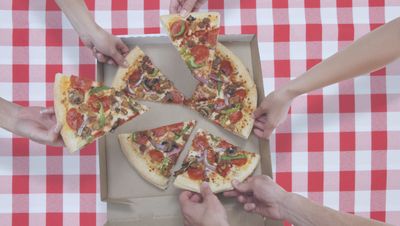See a hot pizza sitting on a table. Count the missing pieces: three. They tasted delicious and yes, you've eaten enough—but you're still eyeing a fourth piece. Do you reach out and take it, or not?
"The difficulty comes in translating the animal data into the human situation."
Your behavior in that next moment is anything but simple: as far as scientists can tell, it comes down to a complex confluence of circumstances, genes, and personality characteristics. And the latest proposed addition to this list is the gut microbiome—the community of microorganisms, including bacteria, archaea, fungi, and viruses—that are full-time residents of your digestive tract.
It is entirely plausible that your gut microbiome might influence your behavior, scientists say: a well-known communication channel, called the gut-brain axis, runs both ways between your brain and your digestive tract. Gut bugs, which are close to the action, could amplify or dampen the messages, thereby shaping how you act. Messages about food-related behaviors could be particularly susceptible to interception by these microorganisms.
Perhaps it's convenient to imagine your resident microbes sitting greedily in your gut, crying for more pizza and tricking your brain into getting them what they want. The problem is, there's a distinct lack of scientific support for this actually happening in humans.
John Bienenstock, professor of pathology and molecular medicine at McMaster University (Canada), has worked on the gut microbiome-behavior connection for several decades. "There's a lot of evidence now in animals—particularly in mice," he says.
Indeed, his group and others have shown that, by eliminating or altering gut bugs, they can make mice exhibit different social behaviors or respond more coolly to stress; they can even make a shy mouse turn brave. But Bienenstock cautions: "The difficulty comes in translating the animal data into the human situation."
Animal behaviors are worlds apart from what we do on a daily basis—from brushing our teeth to navigating complex social situations.
Not that it's an easy task to figure out which aspects of animal research are relevant to people in everyday life. Animal behaviors are worlds apart from what we do on a daily basis—from brushing our teeth to navigating complex social situations.
Elaine Hsiao, assistant professor of integrative biology and physiology at UCLA, has also looked closely at the microbiome-gut-brain axis in mice and pondered how to translate the results into humans. She says, "Both the microbiome and behavior vary substantially [from person to person] and can be strongly influenced by environmental factors—which makes it difficult to run a well-controlled study on effects of the microbiome on human behavior."
She adds, "Human behaviors are very complex and the metrics used to quantify behavior are often not precise enough to derive clear interpretations." So the challenge is not only to figure out what people actually do, but also to give those actions numerical codes that allow them to be compared against other actions.
Hsiao and colleagues are nevertheless attempting to make connections: building on some animal research, their recent study found a three-way association in humans between molecules produced by their gut bacteria (that is, indole metabolites), the connectedness of different brain regions as measured through functional magnetic resonance imaging, and measures of behavior: questionnaires assessing food addiction and anxiety.
Meanwhile, other studies have found it may be possible to change a person's behavior through either probiotics or gut-localized antibiotics. Several probiotics even show promise for altering behavior in clinical conditions like depression. Yet how these phenomena occur is still unknown and, overall, scientists lack solid evidence on how bugs control behavior.
Bienenstock, however, is one of many continuing to investigate. He says, "Some of these observations are very striking. They're so striking that clearly something's up."
He says that after identifying a behavior-changing bug, or set of bugs, in mice: "The obvious next thing is: How [is it] occurring? Why is it occurring? What are the molecules involved?" Bienenstock favors the approach of nailing down a mechanism in animal models before starting to investigate its relevance to humans.
He explains, "[This preclinical work] should allow us to identify either target molecules or target pathways, which then can be translated."
Bienenstock also acknowledges the 'hype' that appears to surround this particular field of study. Despite the decidedly slow emergence of data linking the microbiome to human behavior, scientific reviews have appeared in brain-related scientific journals—for instance, Trends in Cognitive Sciences; CNS Drugs—with remarkable frequency. Not only this, but popular books and media articles have given the idea wings.
It might be compelling to blame our microbiomes for behaviors we don't prefer or can't explain—like reaching for another slice of pizza. But until the scientific observations yield stronger results, we still lack proof that we're doing what we do—or eating what we eat—exclusively at the behest of our resident microorganisms.
